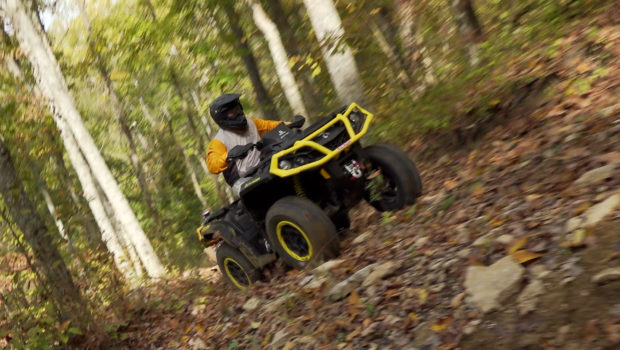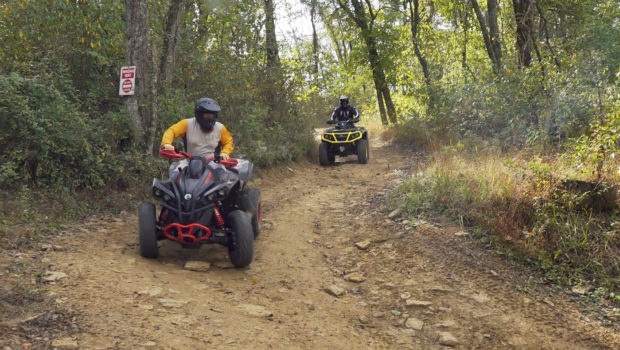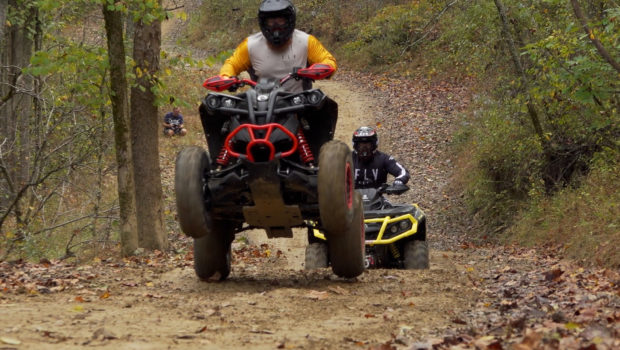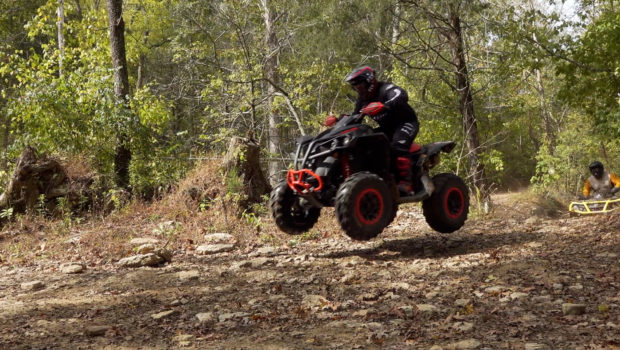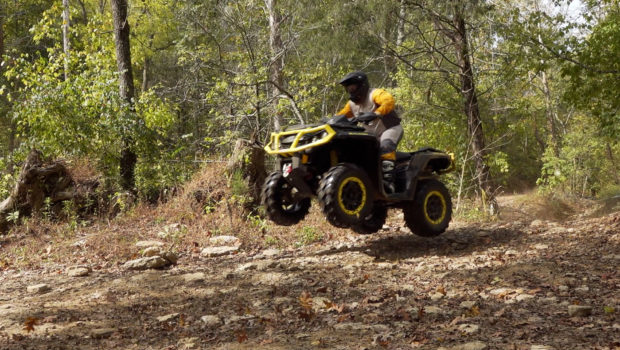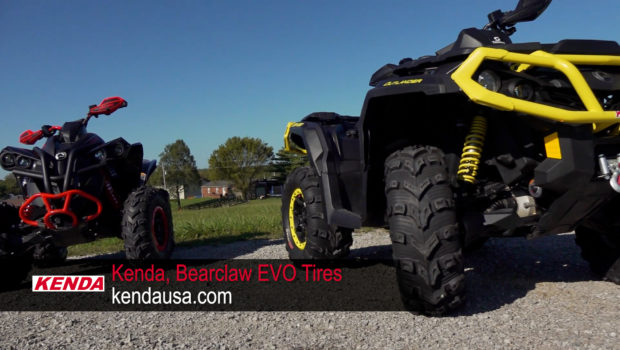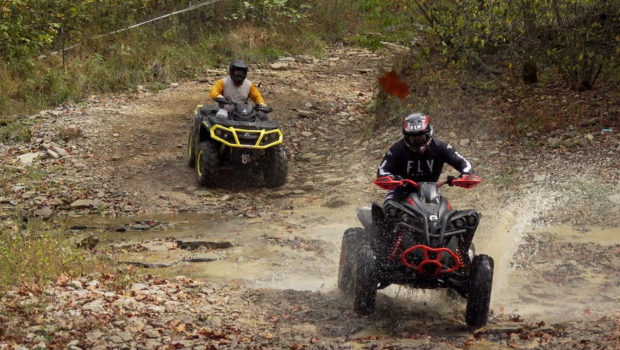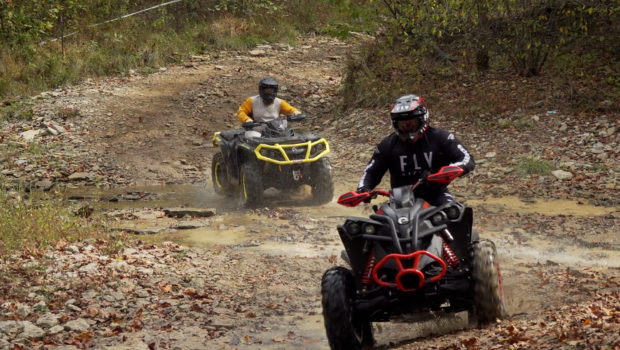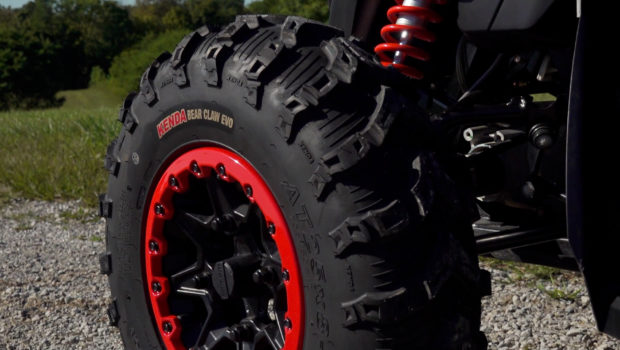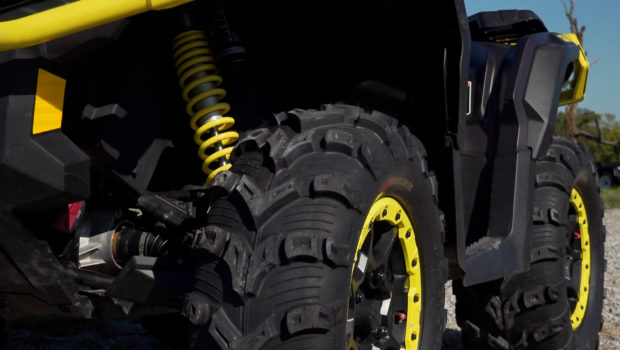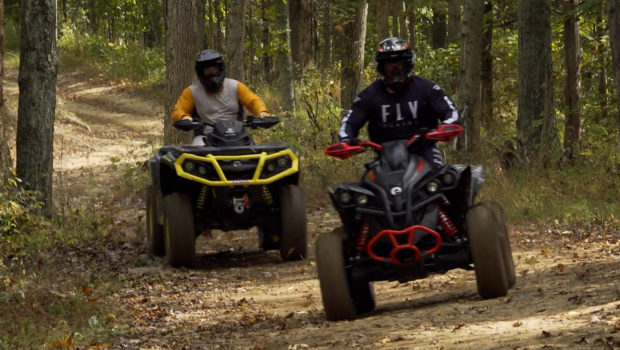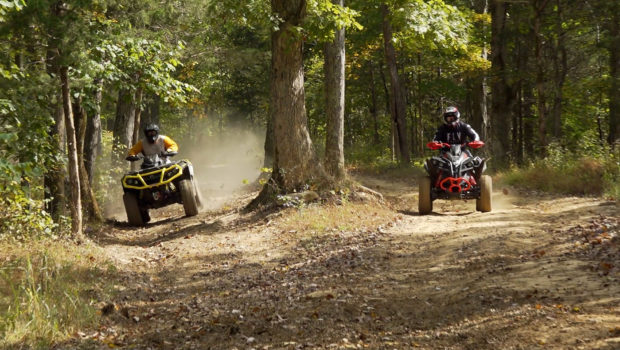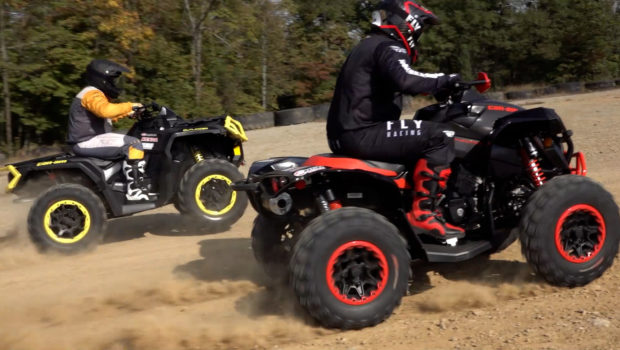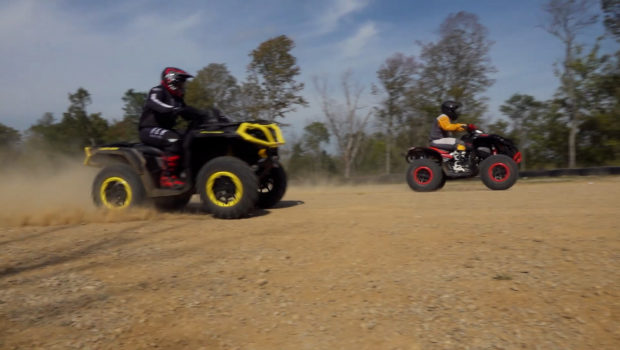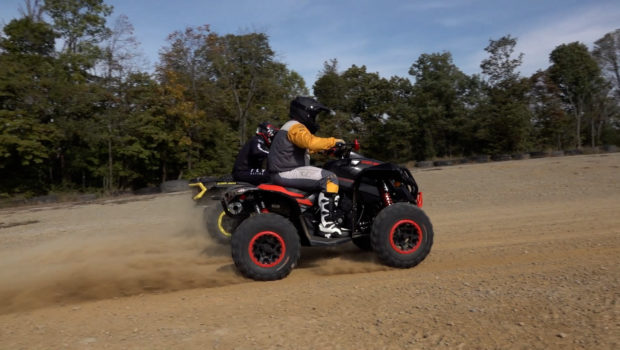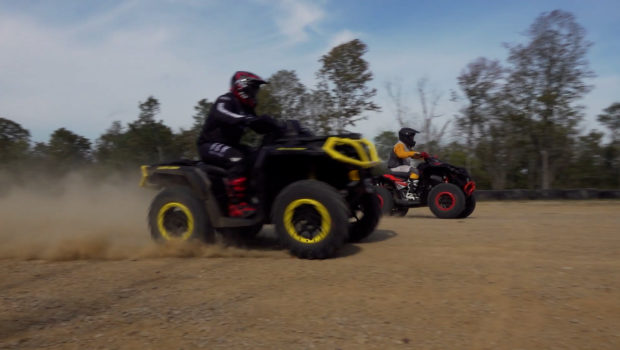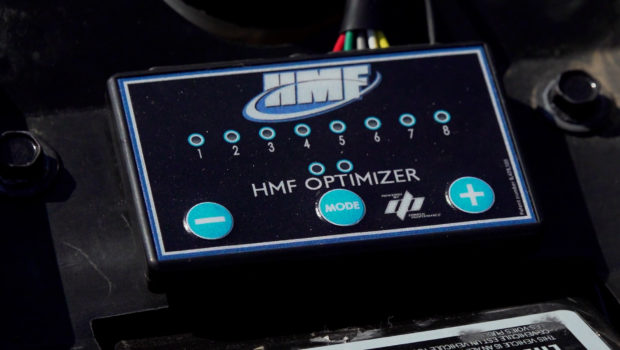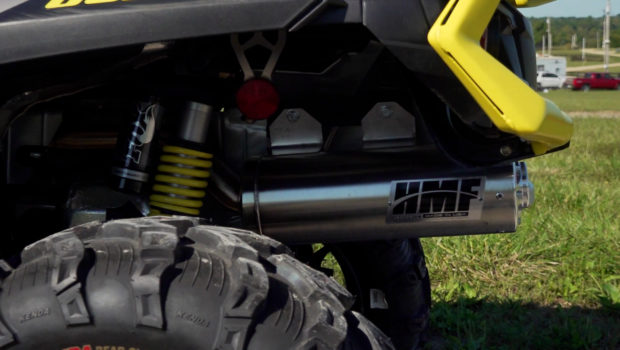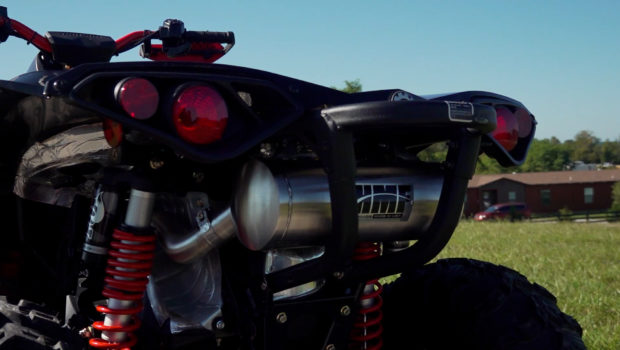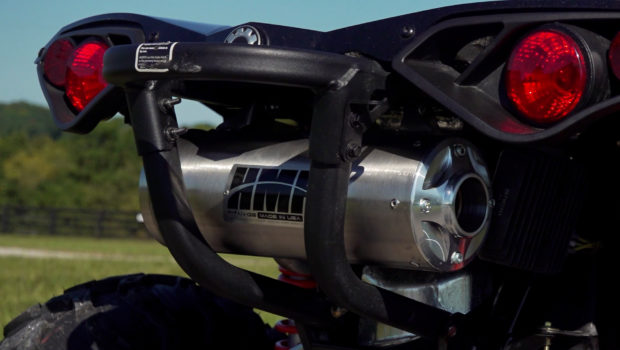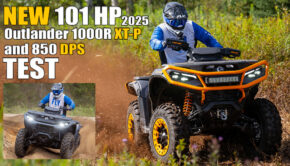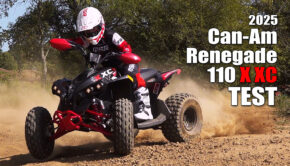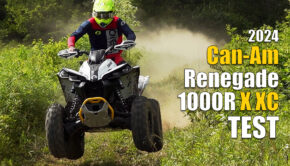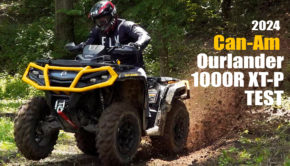Published on December 1st, 2021 | by Joe
Can-Am Renegade 1000R X-XC vs Outlander 1000R XT-P
ATVonDemand test riders Chad Westcott and Brent Johnson took a trip to Dirty Turtle Off-Road park in Bedford Ky to put 182 HP of the most powerful, trial focused, 4×4 ATVs head to head. The Can-Am Renegade 1000R X XC and Outlander 1000R XT-P.
Choosing between these machines could be tough. We know we’d be leaving a lot of capability on the table if we went with the Renegade, because the Outlander is an ideal tool for working, hunting, and camping. But how much performance would we leave on the table if we didn’t choose the Renegade and are there any other important differences we might not be considering.
With those questions in mind we geared up and headed out to hit Dirty Turtles scenic one way trail system, but quickly got distracted by a long gravel road between the parking areas that looked ideal for starting out with some friendly drag races. Ordinarily, we wouldn’t condone this type of parking lot hooliganry but with Dirty Turtle closed for the day, we couldn’t pass up an opportunity to line these beasts up.
Can-Am tells us they share identically tuned 91 HP Rotax 1000R engines with identical clutching, but we still expected the Renegade to pull out in front based on it’s lighter weight and the fact that it’s a friggen Renegade.
With ideal starts, the Renegade does feel a bit snappier off the line than it’s beefier brother, but the combination of hard acceleration and loose gravel caused it to float off line a bit. That’s a phenomenon created by the powerplant and clutching combo that’s second to none in the market, and a sensation that really only bothers you if you’re drag racing for pinks.
The Outlander still feels snappy despite the extra weight, and that weight is a bit of an asset when the front tire is searching for traction with the 4×4 engaged.
There’s no doubt that these machines are powerful, but for those who just can’t get enough power, there’s an additional 10-15% more horsepower available from a good aftermarket exhaust like HMF’s Titan, Performance or Swamp series exhaust combined with their pre-programmed machine and exhaust specific Fuel Optimizer.
Having proven their performance value in our 2020 1000cc 4×4 ATV Shootout, we installed HMF Titan Quiet, slip-on exhausts and Fuel Optimizers on both Can-Am 1000s to unleash their stock horsepower potential and reduce operating temperatures. Their clean stainless steel construction with blackout option available cleans up the look of the stock cans. Best of all, the Titan Quiet system keeps sound output very close to stock decibels while providing a deeper throatier sound.
I guess it shouldn’t be a surprise that initially these machines have a very similar feel despite their aesthetic differences. The entire chassis are virtually identical sharing the same 48” width and 51” wheelbase.
Suspension travel is also identical with 9.2” up front and 9.9” out back. Fox Podium 1.5 shocks are used on both machines. The Renegade’s Podium RC2 shocks feature all the external adjustments you’d expect from high-end race shocks. The Outlander’s Podium QS3 shocks feature threaded spring preload along with simple intuitive 3-way compression damping settings.
Each machine’s suspension valving and spring rates are slightly different to match their intended uses. The Renegade’s stock suspension setting is pretty stiff for the average trail rider but well suited to its aggressive intention. The Outlander XT-P is well prepared for spirited riding, but it’s set up a little more plush from the factory which seems appropriate for its intended use as well.
Power steering settings are slightly different with the two machines primarily for their different tire sizes. For the majority of a long ride day like this one, we opted to leave the DPS in the maximum assistance on the CanAms in order to keep the steering light for all day riding.
Identical hydraulic disc brakes stop both machines and do a pretty good job of it too considering our rider and machine combos are nearly a half a ton of Rotax propelled mass.
Both ATVs also come outfitted with great looking cast aluminum beadlock wheels. The Renegade uses race-appropriate 12” wheels while the Outlander uses slightly larger 14” wheels.
Our Outlander has been around a little longer than the Renegade so in order to even the performance playing field, we opted to outfit both machines with a fresh set of Kenda Bearclaw EVO tires.
Heavy tires can have a negative impact on power transfer and handling. So Kenda’s Bearclaw EVO tires were developed with a priority on keeping weight down without sacrificing durability. This makes them ideal for 4×4 ATV applications unlike many SXS focused tires that are saturating the market today. Bearclaw EVOs are designed for exceptional acceleration and braking in all types of terrain and their directional design will help maximize steering accuracy on these high horsepower monsters. Like the stock tires we went with 25” EVOs on the Renegade and 26” EVOs on the Outlander.
Of course the larger tires, larger wheels, increased coverage plastic bodywork, racks, winch, and hitch add up, making the Outlander a little over 100 pounds heavier than the Renegade’s stock 710lb claimed dry weight. But we’re not the kind of test riders who are afraid of few extra lbs. Especially when each additional pound comes with a purpose.
Larger tires increase ground clearance, the extra plastic keeps the rider fresh and dry, an racks, winch, and a hitch make the Outlander so much more than just a one trick pony.
The Renegade on the other hand makes no apologies for what it is, it came to rip and doesn;t care about anything else. Sure you could force the issue by adding a hitch or awkwardly securing some cargo but it’s never going to have the capacity of the Outlander.
You can feel the difference in weight between the machines, especially in the front end of the Outlander, which, as mentioned in the drag race, isn’t always a disadvantage. Dirty Turtle offers ample opportunity to test both the traction of our Kenda BearClaw EVOs and the capability of the machines on steep inclines and Brent and I both appreciated the slight advantage the Outlander had with a few extra lbs up front.
It’s harder to feel the performance advantage that the Renegade clearly had in the drag races while in a trail setting, and that’s not a dig on the Renegades performance so much as it is a testament how little the weight mattered to us on the trail. While racers are always looking to gain every advantage they can by shedding every possible pound, the more casual rider, which is basically everyone else, shouldn’t let the weight be the dealer breaker in a buying decision.
The handling on the big CanAms is very similar. CanAM told us the DPS was tuned slightly differently on each machine, however, that was to compensate for the difference in tire sizes, so while we switched back and forth between machines there was no noticeable difference in the power steering.
There was a noticeable difference in the suspension with the Outlander being softer which Brent and I both appreciated. Even as we turned up the intensity, the factory setting of the Outlander never gave anything up in terms of performance or running out of travel. The softer suspension setting helped absorb some of the trail chop and provided a milder feel through the handlebars which makes long rides more comfortable.
As we mentioned early, the Renegade’s factory suspension is set up for aggressive riding. The Fox Podium RC2 Suspension of the renegade provides more adjustment capability R- for Rebound as well as high and low speed compression adjustment C2. So a rider interested in truly fine tuning their suspension is going to appreciate the adjustability of the Renegade.
For those who want convenience the Outlander’s QS3 setup allows you to quickly select between 3 compression settings. You lose some of the fine tunability but gain the option of easily selecting between softer or firmer settings to adjust to your riding conditions.
Towards the end of the day we made some uninterrupted spirited runs around Dirty Turtle’s perimeter trail where we learned even more about the machines.
First off, we really appreciated the throaty sound of our HMF exhausts, but perhaps equally important was the reduced operating temperatures we noticed by adding the HMF fuel programmers. Emission restrictions have most factory machines running a little lean which increases engine heat. Simply adding the programmer gets the heat under control, even on what was probably the last warm ride day of the season, we never noticed excessive heat from either machine.
Secondly, the day didn’t go exactly as planned in terms of our expectations. We’ve had more experience with the Outlander in previous tests and comparisons but this was both Brent and I’s first experience with the Renegade.
With bias towards the Renegade created by the aggressive styling and the small but distinct advantages on the spec sheet, we expected to be fighting over the Renegade all day. We knew from our 2020 1000cc shootout that the Outlander outperforms the competition and I think we were expecting a performance gap between the Renegade and Outlander that would be similar to that shootout.
Keeping in mind that we were essentially comparing the factory set of each machine, we both preferred the ride of the Outlander. Whether it was a difference in balance created by adding the extra weight or the more forgiving suspension absorbing the choppy terrain, and in all likelihood it was a combination of both, we both felt more comfortable with Outlander. It wasn’t just a plusher ride either, the machine tract better through corners and remained noticeably more predictable on basically every surface.
The Renegades lighter front end and stiffer suspension made it feel less compliant in most situations. Now we should point out that the trails at Dirty Turtle are a far cry from the rough and rutted XC tracks that the Renegade is set up for and we expect this story might be different had our test facility been a GNCC course. But for a trail rider, the RC2 Shocks of the Renegade would need some fine tuning to absorb the typical chop of a well worn East Coast trail.
As we finished our laps and our ride for the day it was pretty obvious to both of us what our decision would be if we were choosing between these machines. We’d opt for the greater utility of the Outlander in XT-P trim and sleep peacefully knowing we weren’t giving up much performance.
But if you’re still having trouble deciding between the two keep in mind that CanAm’s premium options are customizable, and the perfect blend of performance and utility for you could be the Outlander in X-XC trim.

